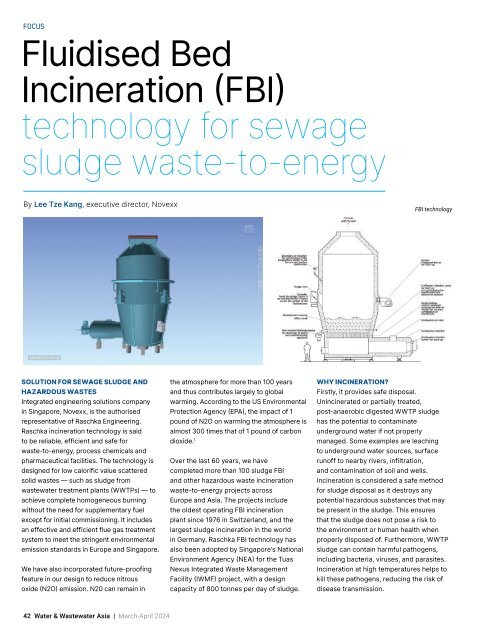Water & Wastewater Asia March/April 2024
Water & Wastewater Asia is an expert source of industry information, cementing its position as an indispensable tool for trade professionals in the water and wastewater industry. As the most reliable publication in the region, industry experts turn this premium journal for credible journalism and exclusive insight provided by fellow industry professionals. Water & Wastewater Asia incorporates the official newsletter of the Singapore Water Association (SWA).
Water & Wastewater Asia is an expert source of industry information, cementing its position as an indispensable tool for trade professionals in the water and wastewater industry. As the most reliable publication in the region, industry experts turn this premium journal for credible journalism and exclusive insight provided by fellow industry professionals. Water & Wastewater Asia incorporates the official newsletter of the Singapore Water Association (SWA).
You also want an ePaper? Increase the reach of your titles
YUMPU automatically turns print PDFs into web optimized ePapers that Google loves.
FOCUS<br />
Fluidised Bed<br />
Incineration (FBI)<br />
technology for sewage<br />
sludge waste-to-energy<br />
By Lee Tze Kang, executive director, Novexx<br />
FBI technology<br />
SOLUTION FOR SEWAGE SLUDGE AND<br />
HAZARDOUS WASTES<br />
Integrated engineering solutions company<br />
in Singapore, Novexx, is the authorised<br />
representative of Raschka Engineering.<br />
Raschka incineration technology is said<br />
to be reliable, efficient and safe for<br />
waste-to-energy, process chemicals and<br />
pharmaceutical facilities. The technology is<br />
designed for low calorific value scattered<br />
solid wastes — such as sludge from<br />
wastewater treatment plants (WWTPs) — to<br />
achieve complete homogeneous burning<br />
without the need for supplementary fuel<br />
except for initial commissioning. It includes<br />
an effective and efficient flue gas treatment<br />
system to meet the stringent environmental<br />
emission standards in Europe and Singapore.<br />
We have also incorporated future-proofing<br />
feature in our design to reduce nitrous<br />
oxide (N2O) emission. N20 can remain in<br />
the atmosphere for more than 100 years<br />
and thus contributes largely to global<br />
warming. According to the US Environmental<br />
Protection Agency (EPA), the impact of 1<br />
pound of N2O on warming the atmosphere is<br />
almost 300 times that of 1 pound of carbon<br />
dioxide. 1<br />
Over the last 60 years, we have<br />
completed more than 100 sludge FBI<br />
and other hazardous waste incineration<br />
waste-to-energy projects across<br />
Europe and <strong>Asia</strong>. The projects include<br />
the oldest operating FBI incineration<br />
plant since 1976 in Switzerland, and the<br />
largest sludge incineration in the world<br />
in Germany. Raschka FBI technology has<br />
also been adopted by Singapore’s National<br />
Environment Agency (NEA) for the Tuas<br />
Nexus Integrated Waste Management<br />
Facility (IWMF) project, with a design<br />
capacity of 800 tonnes per day of sludge.<br />
WHY INCINERATION?<br />
Firstly, it provides safe disposal.<br />
Unincinerated or partially treated,<br />
post-anaerobic digested WWTP sludge<br />
has the potential to contaminate<br />
underground water if not properly<br />
managed. Some examples are leaching<br />
to underground water sources, surface<br />
runoff to nearby rivers, infiltration,<br />
and contamination of soil and wells.<br />
Incineration is considered a safe method<br />
for sludge disposal as it destroys any<br />
potential hazardous substances that may<br />
be present in the sludge. This ensures<br />
that the sludge does not pose a risk to<br />
the environment or human health when<br />
properly disposed of. Furthermore, WWTP<br />
sludge can contain harmful pathogens,<br />
including bacteria, viruses, and parasites.<br />
Incineration at high temperatures helps to<br />
kill these pathogens, reducing the risk of<br />
disease transmission.<br />
42 <strong>Water</strong> & <strong>Wastewater</strong> <strong>Asia</strong> | <strong>March</strong>-<strong>April</strong> <strong>2024</strong>

















